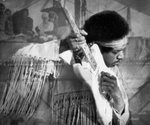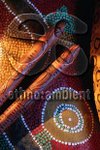
Blood, Sweat & Tears (a.k.a. "B,S&T") was an American music group, formed in 1967 in New York City. It fused rock, blues, pop music, horn arrangements and jazz improvisation into a hybrid that came to be known as "jazz-rock". Unlike "jazz fusion" or simply "fusion", which tended toward virtuostic displays of instrumental facility and some experimentation with electric instruments, Blood, Sweat & Tears' sound merged the varied stylings of rock, pop and R&B/soul music with big band coupled with "combo" (small ensemble) jazz.
These guys got off to an excellent start with Child Is Father To The Man,their first release. This one and their self titled 2nd outing, are easily their best work. The only BS&T album with Al Kooper taking the lead role,before the days of David Clayton-Thomas, it has a sound all it's own. Different from anything that followed. More of a classical taste than on their others,but the classical flavor does not dominate, the brass makes it's presence known, and there is a great rock sound through out. The vocals are great, as is the song writing. This was a ground breaking album when it first came out, and still sounds fresh today. - Thomas D. Christianson
Child Is Father To The Man
Tracks
1. Overture
2. I Love You More Than You'll Ever Know
3. Morning Glory
4. My Days Are Numbered
5. Without Her
6. Just One Smile
7. I Can't Quit Her
8. Meagan's Gypsy Eyes
9. Somethin' Goin' On
10. House In The Country
11. The Modern Adventures Of Plato, Diogenes And Freud
12. So Much Love/Underture

With the departure of lead singer Al Kooper, Blood Sweat & Tears inducted David Clayton-Thomas as a replacement, which was fortuitous for him, as he presided over what was BS&T's masterpiece album of 1969. This album topped the charts, garnered the Best Album Grammy and it's not difficult to see why. BS&T's fusion of funk, rock, and jazz signalled an innovation in music from the guitar-dominated rock of the early to mid-60's. The horns, bass, and piano prevalent in jazz music add much to a blues-based rock sound that had emerged with the British-led blues revival of the 60's.The album itself begins with lilting and reflective flute melodies of atonal composer Erik Satie's "Trois Gymnopedies" of which BS&T do variations on a theme based on the first two movements, the latter which has the horns kicking in. The variation on the first movement also closes the album, not including the bonus tracks.
BS&T do quite a few cover songs, and they add horns and a funky beat to the psychedelic organ of Traffic's "Smiling Phases," originally on their Mr. Fantasy album. Those inclined will be "amazed at the gaze on their faces."
The relaxed and lyrically introspective remembrances in "Sometimes In Winter" includes organs, a burst of horns at an orchestral level, which is mixed with yearning for "memories in a spring that never came," a remarkable contrast to the strong horn attack, intense organ, and gritty and belting blues vocals of the rocking "More And More."
The next four songs comprise the majestic centerpiece of this classic album, as three of the four became hit singles. "And When I Die" is a cover of a Laura Nyro song from her first album More Than a New Discovery, beginning as it does with a harmonica, then thrusting into a summery skipping soul/country beat with vocals tempo to match. Despite the title, it has an upbeat outlook: "and when I die, and when I'm gone, there'll be one child born in this world to carry on" and the figuring out of if there's a heaven by dying. The wishes of a just life is given in "all I ask of living is to have no chains on me." The cover of the Billie Holliday standard "God Bless The Child" incorporates 60's-style organs with the blast of horns and is a welcome interpretation. And then, "what goes up, must come down." Given their career afterwards, those opening words in "Spinning Wheel," the song most associated with the group, seems ironic. The song itself is replete with the funky beat, horns, distorted vocals, and the finale, which features a flute solo incorporating the nursery ditty "My Little Augustine" and a carnival-like swirl of noises. Dr. Farrell played "Spinning Wheel" in our jazz/rock/blues class to demonstrate the jazz/rock sound incorporated by them and Chicago. Finally comes their cover of Brenda Holloway's "You've Made Me So Very Happy," which has been covered by the likes of Honeycone and Gloria Estefan. Clayton-Thomas's gravelly voice belies the soul roots of this song, but it's the rich horn flourishes that give this rendition that extra punch.
"Blues Part II" is a lengthy jam incorporating an organ solo that's space age, (an influence on Philip Glass on the Koyaanisqatsi soundtrack, perhaps?) other times baroque, before it gives way to a meandering bass solo, a masterful sax reminding the listener of the group's jazz influences, but with the backing bass and drums signalling the rock influence. And then, I hear the bass plucking out a familiar melody, before the crashing horns repeat it. Yes, it's Cream's "Sunshine Of Your Love." Finally, Clayton-Thomas belts out some vocals for a final touch. - Daniel J. Hamlow

With the departure of lead singer Al Kooper, Blood Sweat & Tears inducted David Clayton-Thomas as a replacement, which was fortuitous for him, as he presided over what was BS&T's masterpiece album of 1969. This album topped the charts, garnered the Best Album Grammy and it's not difficult to see why. BS&T's fusion of funk, rock, and jazz signalled an innovation in music from the guitar-dominated rock of the early to mid-60's. The horns, bass, and piano prevalent in jazz music add much to a blues-based rock sound that had emerged with the British-led blues revival of the 60's.The album itself begins with lilting and reflective flute melodies of atonal composer Erik Satie's "Trois Gymnopedies" of which BS&T do variations on a theme based on the first two movements, the latter which has the horns kicking in. The variation on the first movement also closes the album, not including the bonus tracks.
BS&T do quite a few cover songs, and they add horns and a funky beat to the psychedelic organ of Traffic's "Smiling Phases," originally on their Mr. Fantasy album. Those inclined will be "amazed at the gaze on their faces."
The relaxed and lyrically introspective remembrances in "Sometimes In Winter" includes organs, a burst of horns at an orchestral level, which is mixed with yearning for "memories in a spring that never came," a remarkable contrast to the strong horn attack, intense organ, and gritty and belting blues vocals of the rocking "More And More."
The next four songs comprise the majestic centerpiece of this classic album, as three of the four became hit singles. "And When I Die" is a cover of a Laura Nyro song from her first album More Than a New Discovery, beginning as it does with a harmonica, then thrusting into a summery skipping soul/country beat with vocals tempo to match. Despite the title, it has an upbeat outlook: "and when I die, and when I'm gone, there'll be one child born in this world to carry on" and the figuring out of if there's a heaven by dying. The wishes of a just life is given in "all I ask of living is to have no chains on me." The cover of the Billie Holliday standard "God Bless The Child" incorporates 60's-style organs with the blast of horns and is a welcome interpretation. And then, "what goes up, must come down." Given their career afterwards, those opening words in "Spinning Wheel," the song most associated with the group, seems ironic. The song itself is replete with the funky beat, horns, distorted vocals, and the finale, which features a flute solo incorporating the nursery ditty "My Little Augustine" and a carnival-like swirl of noises. Dr. Farrell played "Spinning Wheel" in our jazz/rock/blues class to demonstrate the jazz/rock sound incorporated by them and Chicago. Finally comes their cover of Brenda Holloway's "You've Made Me So Very Happy," which has been covered by the likes of Honeycone and Gloria Estefan. Clayton-Thomas's gravelly voice belies the soul roots of this song, but it's the rich horn flourishes that give this rendition that extra punch.
"Blues Part II" is a lengthy jam incorporating an organ solo that's space age, (an influence on Philip Glass on the Koyaanisqatsi soundtrack, perhaps?) other times baroque, before it gives way to a meandering bass solo, a masterful sax reminding the listener of the group's jazz influences, but with the backing bass and drums signalling the rock influence. And then, I hear the bass plucking out a familiar melody, before the crashing horns repeat it. Yes, it's Cream's "Sunshine Of Your Love." Finally, Clayton-Thomas belts out some vocals for a final touch. - Daniel J. Hamlow
Blood, Sweat & Tears
Tracks
1. Variations On A Theme By Erik Satie (1st And 2nd Movements)
2. Smiling Phases
3. Sometimes In Winter
4. More And More
5. And When I Die
6. God Bless The Child
7. Spinning Wheel
8. You've Made Me So Very Happy
9. Blues - Part II
10. Variations On A Theme By Erik Satie (1st Movement)
LINKS:
Child Is Father To The Man
h!!p://www.megaupload.com/?d=YKYR59S5
Blood, Sweat & Tears
h!!p://www.megaupload.com/?d=9DENCCSQ
LINK: (track missing from BST album)
h!!p://www.megaupload.com/?d=5C9TS0X6
Please leave a comment









8 comments:
On "Blood Sweat and Tears" the last track is missing.
Thanx for your input but please check track list at the post topic. Maybe cover does not match tracks. there are various releases of this 2 albums and please check them on the net.
Rockanthology
In fact it's different from what you wrote: "Variations On A Theme By Erik Satie (1st Movement)" is not in the .rar file
O.K. Sorry, I will post it later today as a separate link.
Rockanthology
It is up now. Thanx again for your input.
rockanthology
You're doin' a good job
Tanx!
Bishop
Love this stuff!
my dad listened to BST a lot and I never really had the chance to listen to music, especially now that I am grown up and out of the house. But man a shocker, I really love their sound a lot.
Can't believe how much I am getting into the 70s soul sound, but I'm lovin' every bit of it.
Thanks!
hey man thks alot for the music. great ones..
Post a Comment